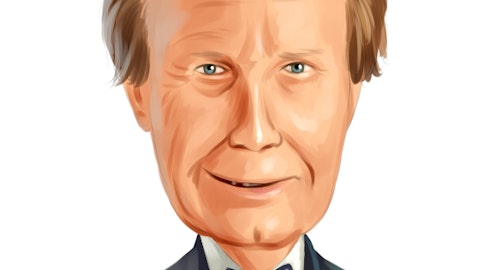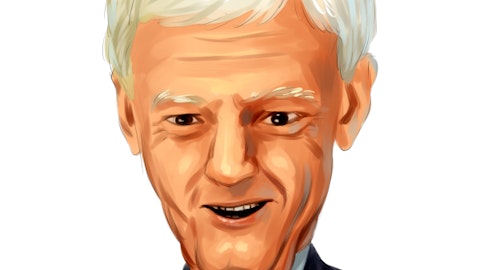Compass Diversified (NYSE:CODI) Q4 2022 Earnings Call Transcript March 1, 2023
Operator: Good afternoon, and welcome to the Compass Diversified Fourth Quarter 2022 Conference Call. Today’s call is being recorded. At this time, I would like to turn the conference over to Cody Slach of Gateway Group for introductions and the reading of the Safe Harbor statement. Please go ahead, sir.
Cody Slach: Thank you, and welcome to Compass Diversified’s fourth quarter and full year 2022 conference call. Representing the company today are Elias Sabo, CODI’s CEO; Ryan Faulkingham, CODI’s CFO; and Pat Maciariello, COO of Compass Group Management. Before we begin, I’d like to point out that the Q4 and full year 2022 press release, including the financial tables and non-GAAP financial measure reconciliations for adjusted EBITDA, adjusted earnings and pro forma net sales are available at the Investor Relations section on the company’s website at compassdiversified.com. The company also filed its Form 10-K with the SEC today after the market closed, which includes reconciliations of certain non-GAAP financial measures discussed on this call and is also available at the Investor Relations section of the company’s website.
Please note that references to EBITDA in the following discussions refer to adjusted EBITDA as reconciled to net income or loss from continuing operations in the company’s financial filings. The company does not provide a reconciliation of its full year expected 2023 adjusted earnings or adjusted EBITDA because certain significant reconciling information is not available without unreasonable efforts. Throughout this call, we will refer to Compass Diversified as CODI or the company. Now allow me to read the following Safe Harbor statement. During this conference call, we may make certain forward-looking statements, including statements with regard to the future performance of CODI and its subsidiaries, the impact and expected timing of acquisitions and future operational plans such as ESG initiatives.
Words such as believes, expects, anticipates, plans, projects and future or similar expressions are intended to identify forward-looking statements. These forward-looking statements are subject to the inherent uncertainties in predicting future results and conditions. Certain factors could cause actual results to differ on a material basis from those projected in these forward-looking statements, and some of these factors are enumerated in the risk factor discussion in the Form 10-Q as filed with the SEC for the quarter ended December 31, 2022, as well as in other SEC filings. In particular, the domestic and global economic environment, supply chain, labor disruptions, inflations and rising interest rates all may have a significant impact on CODI and our subsidiary companies.
Except as required by law, CODI undertakes no obligation to publicly update or revise any forward-looking statements whether as a result of new information, future events or otherwise. At this time, I would like to turn the call over to Elias Sabo.
Elias Sabo: Good afternoon, everyone, and thanks for joining us today. I would like to start by recognizing that 2022 was a phenomenal year for CODI. Despite persistent market headwinds driven by rapidly changing monetary policy, supply chain imbalances, and rising inflation, we produced record annual results. For the full year, our branded consumer net sales were up 14% on a pro form basis, while the net sales of our niche industrial businesses were up 9% helping to drive record adjusted earnings and adjusted EBITDA. These results confirm that our diversified subsidiaries combined with expert operational and financial execution can grow and take share even in a difficult market backdrop. I’d like to acknowledge our recently announced divestiture of Advanced Circuits.
We are proud of our partnership and success with their team which started more than 16 years ago. CODI’s permanent capital structure and support throughout this partnership has generated significant value for our shareholders and we are grateful for their contributions and look forward to their continued success. Jumping back to our 2022 performance, our subsidiaries manage the various macro challenges exceptionally well and we remain confident in their ability to continue to grow and take market share over the long term. That said, our near term outlook is clouded by some unique crosscurrents. Our branded consumer subsidiaries with exposure to wholesale are experiencing significant inventory destocking headwinds. This is being driven by events that unfolded coming out of the pandemic.
In the first half of 2022, we benefited from extremely high demand from customers who needed our product to help manage their own supply chain issues. With the pandemic winding down and some retailers reckoning with the fact that they over ordered, it has created a whipsaw effect until inventory is right sized. For our brands further down the supply chain like BOA and PrimaLoft, the destocking headwinds are exacerbated. Pat will walk through specific brand performance shortly, but I will just say that we expect the first half of 2023 to reflect lower performance from some of our companies with a reacceleration anticipated in the back half as inventory is worked through and comparisons ease. On the other hand, we are seeing no signs of slowing demand with our companies that have material direct to consumer components to their business like 511 and Lugano.
This gives us confidence that the balance sheet of the affluent customer to which we sell many of our products is healthy. More specifically, it tells us that rising wages and the continued imbalance in the labor market are more than offsetting inflation and rising borrowing cost. Notwithstanding the difficult macro climate and inventory headwinds, we firmly believe our subsidiaries are well positioned to achieve their long term growth targets. To demonstrate this, I’d like to highlight one of our niche industrial businesses Arnold Magnetics as a case study of how we improve value for our shareholders. We acquired the business in 2012 based on Arnold’s technology leadership in the permanent magnet subassemblies industry and strong growth tailwinds for the use of permanent magnets to enable the clean energy transformation.
In 2016, we made the decision to replace senior management at Arnold, bringing in Dan Miller as CEO of that subsidiary. As a reminder, Arnold is a long cycle business, and Dan was confronted with the reality of some programs going end of life while the pipeline of new opportunities was extremely weak. Restructuring and repositioning a long cycle business is an especially challenging situation. Entering 2022, Arnold’s strategic priorities have been successfully repositioned to focus on new end markets like aerospace and defense, among others, which match Arnold’s high end, high margin, low volume technical engineering and manufacturing capabilities. Arnold added a tech center to improve its products, advance its technology edge, improve its partnership with its customers, and complete Arnold’s transition from a products company to an engineered solutions company.
We supported Arnold’s acquisition of Ramco Electric Motors to offer turnkey electric motor solutions, further positioning the Arnold business for the green economy. Arnold executed well on this strategy and reported a record breaking year for bookings and double digit sales and EBITDA growth. Arnold ended the year with $83 million in backlog and a book-to-bill ratio of 1.13, setting it up for another strong year in 2023. The strength of this business in the long term runway for growth underscores the power of our diversified permanent capital model, which enables us to make long term decisions to maximize value creation for our shareholders. In 2022, we launched our first new vertical since coming public entering into the healthcare vertical with the announcement of Kurt Roth as our leader.
Kurt brings over 25 years of experience and a decade long partnership with CODI, and we couldn’t be more excited to have him at the helm. Since his joining, Kurt and his team have been working hard at developing a robust pipeline of M&A targets. Like other markets, deal activity has been suppressed by the macro environment, but we remain proactive and prepared for the inevitable turnaround. Before turning the call over to Pat, I would like to summarize our performance and outlook. 2022 was a record breaking year despite unprecedented headwinds proving the strength and durability of our subsidiaries and the power of our permanent capital structure. As we sit here today, the majority of our businesses are performing above our expectations and we believe are well positioned to achieve their growth potential.
A few of our businesses are working through the inventory shock that is making its way through the marketplace in a post-pandemic world. We believe these headwinds will be short lived and expect a recovery in the back half of the year. Our financial outlook takes into consideration these headwinds. But the power of diversification is real and implicit in this outlook. For example, we expect our niche industrial segment to have another year of robust growth in 2023. And we expect BOA, who is currently in the crosshair of the inventory destocking headwind to be down versus 2022, but up versus 2021, which was an extraordinary year of growth. Notwithstanding a weaker demand outlook, we are confident in our company’s competitive positioning and market share growth and believe we are poised to outperform our peers.
With that, I will now turn the call over to Pat.
Pat Maciariello: Thanks, Elias. Throughout this presentation, when we discuss pro form results, it will be as if we own PrimaLoft and Lugano from January 1, 2021. On a combined basis, pro form revenue and adjusted EBITDA in both our branded consumer and our niche industrial businesses grew significantly in 2022 and exceeded our expectations. For the year, pro form revenue grew by 12% and pro form adjusted EBITDA grew by 13% to $467 million. Excluding Advanced Circuits, pro form adjusted EBITDA grew by 14% percent in 2022. In the fourth quarter, on a consolidated basis, pro form revenue and adjusted EBITDA growth met our expectations growing by 4% and 3% respectively. Before I get to our subsidiary results, I want to provide a high level view of the quarter.
As Elias mentioned in Q4, several of the businesses in our consumer segment were impacted by inventory drawdowns in the supply chain and therefore our sales of these subsidiaries lagged end consumer demand for their products. This impact was most pronounced that our businesses who operate further down the supply chain, specifically BOA and PrimaLoft. As mentioned, we see this trend continuing in the first half of 2023. Despite the challenges in the quarter on a consolidated basis, we were able to meet our expectations. Our subsidiary management teams once again executed well in a continuously changing environment. Now, on to our subsidiary results. I’ll begin with our niche industrial businesses. For 2022, revenues increased by 9% and adjusted EBITDA increased by 8% versus 2021.
Excluding Advanced Circuits, revenues increased by 10% and adjusted EBITDA increased by 11% in 2022. Driving these results, were meaningful revenue and adjusted EBITDA growth from Arnold and Altor. Arnold continued to show improving margins driven by technology investments made over the last several years and is benefiting from a shift in its sales mix towards higher growth industries focused on electrification. As we mentioned last quarter, the company comped against a very large defense related order that benefited Q4 ’21, but the company’s book-to-bill ratio remains very strong and we believe points to continued growth in ’23. Altor once again had solid growth in the quarter. Gross margins improved both sequentially and versus Q4 ’21. And we expect this trend to continue as raw material price pressures continue to abate and Altor management achieves efficiency gains.
The Sterno Group was down slightly in the quarter and for ’22. Though the company’s food service business is benefiting from the continued return to normal levels of activities and travel and conferences, the company continued to see pressure in sales of its value driven line of scented waxes. On a combined basis, we believe this business will be stable in ’23 and likely will return to moderate growth. Turning to our consumer businesses. For 2022, pro form revenues increased by 14% and pro form adjusted EBITDA increased by 15% as compared to 2021. BOA had a very strong ’22 and finished the year with 26% and 38% growth in revenue and adjusted EBITDA respectively. For the fourth quarter, however, revenue declined slightly and EBITDA was approximately flat due to the factors we discussed.
We believe these supply chain pressures will continue in the first half of 2023, part of the company returning to growth in the back half of the year. To put what we are seeing at BOA in the context. CODI purchased the company in late 2020 and in that year, BOA produced slightly over $30 million of EBITDA. Due to significant market share gains and strong consumer demand for products incorporating BOA’s technology, the company grew to over $60 million in adjusted EBITDA in 2021 and most recently over $82 million in 2022. We believe the inventory destocking headwinds discussed will lead to a short term decline in financial performance in 2023. We believe performance will be above 2021 levels. We are also confident that the company will then return to growth as these pressures abates.
Headwinds notwithstanding, BOA is making significant strides in market share and expansion of its technologies measured by it’s model count on which BOA products are used, the fall winter 2023 season will see growth of close to 10% which is expected to accelerate further in fall winter 2024 based on initial discussions with Brand Partners. In addition, we worked static at the market receptance to BOA’s Alpine ski technology as four of the company’s brand partners recently pre-launched Alpine ski boots integrating the BOA system giving skiers unprecedented fit and performance. The quantities are limited until the official launch this fall for the 2023-2024 ski season. The excitement is significant. And we believe that with its brand partners, BOA has the opportunity to revolutionize fit in the industry.
Lugano’s growth continued in the fourth quarter and for the year as both revenue and EBITDA grew by over 45% and 60% respectively. In the quarter, we benefited from the recent openings of Lugano’s Houston salon and its flagship salon at Fashion Island and Newport Beach. In addition, the company continued to benefit from increases in average transaction size. In 2023, the company will open locations in Washington DC and Greenwich Connecticut and is considering other avenues for geographic expansion and additional new flagship salons. Marucci continued upon its strong run of quarters as sell through and reorders of its CATX line of bats were above expectations and the company continued growing in new markets. For the year, Marucci’s revenue and EBITDA grew by 40% and 27% respectively.
Marucci’s margins remained strong in the quarter as supply chain related issues continue to improve. Marucci continued to diversify its product mix and enter new markets in 2022. The company saw significant growth in its apparel and fueling glove categories and made significant inroads geographically through opening its Japanese operations. The 2023 represents a year without a major cat bat launch. The company is launching several new products and its growth in adjacent categories and geographies drives optimism for the year. 511 continue to buck the trend of struggling apparel brands and in 2022 grew revenue and EBITDA by 9% and 6% respectively. We remain proud of the company’s performance in a difficult environment. In the fourth quarter, EBITDA growth outpaced revenue growth and the company’s DTC comps remained positive led by strong e-commerce sales.
5.11 is having a solid start to 2023 and we believe it will be another year of growth for the company. Turning now to PrimaLoft. In 2022 pro forma revenue and EBITDA increased by 21% and 24% respectively. In the fourth quarter, on a pro forma basis, revenue growth grew slightly and EBITDA declined slightly from 2021 as the company’s price increases did not take effect until the end of 2022 and several extraneous factors led to higher margins in Q4 of 2021. Despite facing similar challenges BOA given its position in the supply chain and inventory levels within the channel, we believe PrimaLoft will fuel growth this year and remain confident in the medium and long-term outlook for the business. Velocity Outdoor continued to struggle in the fourth quarter as inventory levels at retail and its archery business remained high and sell through remains challenged in both segments of the business following COVID-related surges and outdoor activities.
We’re working diligently with management to rationalize the company’s cost structure to this new environment, while remaining focused on innovation. We expect a challenging first half of 2023 for this business as we proceed down this path, but are confident in the outcome. As a whole, we are very pleased with the performance of our businesses in 2022. Though the fourth quarter was challenging for several subsidiaries and the outlook for the first half of the year is mixed in several places. We are confident in the positioning of our businesses and the outlook for CODI. I will now turn the call over to Ryan for additional comments on our financial results.
Ryan Faulkingham: Thank you, Pat. Moving to our consolidated financial results for the quarter ended December 31, 2022, I will limit my comments largely to the overall results for CODI. Since the individual subsidiary results are detailed in our Form 10-K that was filed with the SEC earlier today. As a reminder, our sale of Advanced Circuits occurred in the first quarter of 2023. ACI’s results of operations are included in our fourth quarter and full year 2022 operating results. ACI will be reclassified to discontinued operations in our first quarter of 2023 10-Q. In addition, our 2023 guidance discussion that I’ll make shortly excludes ACI’s results. Now to our quarterly consolidated results. On a consolidated basis, revenue for the quarter ended December 31, 2022 was $594.9 million up 6% compared to $559.9 million for the prior year period.
This year-over-year increase primarily reflects our acquisition of PrimaLoft during the third quarter of 2022. In addition, we had strong sales growth at our branded consumer subsidiaries on a combined basis. Consolidated net loss for the fourth quarter was $11.8 million compared to net income of $25.9 million in the prior year. The decrease was primarily due to a $20.6 million impairment of our Ergobaby subsidiary in the fourth quarter and an increase in management fees and interest expense as a result of the PrimaLoft acquisition in the third quarter. Adjusted EBITDA in the fourth quarter was $87.3 million up 5% compared to $83.3 million in the fourth quarter of 2021. For the full year, adjusted EBITDA was $369.8 million up 20% compared to a year ago.
The increase was primarily due to the strong performance at CODI’s branded consumer subsidiaries and the benefit of the PrimaLoft and Lugano acquisitions. Adjusted earnings for the fourth quarter, was in line with our expectations at $28.7 million down from $37.1 million in the prior year quarter. This decline was primarily a result of financing costs for the acquisition of PrimaLoft in July ahead of its seasonally slow third and fourth quarter earnings periods. Now on to our financial outlook for 2023, which is unchanged versus the preliminary expectations we shared at our January Investor Day. However, now excludes Advanced Circuits. For the full year 2023, we expect consolidated subsidiary adjusted EBITDA to range between $420 million and $460 million and we expect adjusted earnings to range between $105 million and $135 million.
As Elias and Pat have covered well, this outlook expects a challenging first half of the year given the headwinds discussed and then a reacceleration in the second half of the year. Turning to our balance sheet as of December 31, 2022, we had approximately $61.3 million in cash, approximately $443 million available on our revolver and our leverage was 3.97 times. We have substantial liquidity and as previously communicated we have the ability to upsize our revolver capacity by an additional $250 million. Subsequent to year end, we received approximately $170 million in net proceeds from the sale of Advanced Circuits, which we use to repay our revolver balance and reduce our leverage levels. With this liquidity and capital we stand ready and able to provide our subsidiaries with the financial support they need, invest in subsidiary growth opportunities and act on compelling acquisition opportunities as they present themselves.
Turning now to cash flow, during the fourth quarter of ’22, we received $11.6 million of cash flow from operations, primarily a result of strong operating performance. We used $29.2 million in working capital during the fourth quarter and continue to strategically increase inventory levels at Lugano to support near term demand. We expect to produce strong consolidated cash conversion in 2023. Also of note during the fourth quarter, the manager waived 50% of the management fee owed by the company in respect of PrimaLoft. And finally, turning to capital expenditures, during the fourth quarter of 2022, we incurred $24.6 million of capital expenditures of our existing subsidiaries compared to $12.6 million in the prior year period. The increase was primarily a result of the timing of retail build outs at Lugano in 5.11 to support their continued growth.
For full year of 2023, we anticipate total CapEx spend of between $70 million and $80 million. This spend will be in line with 2022, we continue to see strong returns on invested capital at several of our growth subsidiaries and believe they will have short payback periods. The 2023 capital expenditure spend will primarily be at Lugano for new retail salons in Washington D.C. and Greenwich, Connecticut as well as expansion of its Palm Beach, Florida location and at 5.11 as we continue to increase its retail store count from its current 117 stores. With that, I will now turn the call back over to Elias.
Elias Sabo: Thank you, Ryan. I would like to close by briefly providing an update on the M&A market and our strategic initiatives. M&A activity continues to be significantly below historical levels. We are hopeful that the M&A environment improves in the back half of 2023 if economic headwinds moderate. On the ESG front, we continue to advance our key initiatives and we’re excited to announce that in the fourth quarter, we implemented a customized ESG technology platform for data collection, which will enable us to consider setting time bound targets in the future. In fact, we are already preparing to collect Scope 1 and 2 emissions data for our subsidiaries. This will aid in the continued advancement of our ESG platform and ensure we are tracking the necessary metrics in order to regularly improve our ESG strategy.
We also publicly released our corporate citizenship statement on our website which provides shareholders access to information on our ESG approach and a summary of our policy. In conclusion, we’re proud of our 2022 results, which were significantly ahead of our expectations despite a challenging macro backdrop. I’d like to thank our management teams and employees for their continued commitment to success. With that, operator, please open up the lines for Q&A.
See also 15 Most Profitable Penny Stocks and 11 Most Promising Cancer Stocks .
Q&A Session
Follow Compass Diversified Holdings (NYSE:CODI)
Follow Compass Diversified Holdings (NYSE:CODI)
Operator: Your first question comes from the line of Cris Kennedy from William Blair. Cris Kennedy, please go ahead. Your line is open.
Cris Kennedy: Yes, good afternoon and thank you for taking the questions. It’s clear the first half will be a little bit more challenging relative to the second half. Can you give us an update on kind of trends quarter to-date and how we should think about first half performance relative to the second half, if you can? Thank you.
Elias Sabo: Sure, Cris and thank you for the question. Yes, I mean, it’s apparent to us that the first half is going to be difficult and it really is due to inventory destocking. I mean, what we’re hearing in the companies that are having the biggest challenge BOA and PrimaLoft is that our products in the end market are actually selling really well. And so, I think as we tried to highlight ’22 was abnormal in the first half due to the supply chain issues that caused an overordering throughout the end of 21 and then a fulfillment in ’22. So if you think about it, we’re comping against a really kind of high level in ’22 and then we have to burn off some of this inventory. And I think it’s masking some of the kind of positioning within the companies that is just much better.
And Pat alluded to, BOA for example, where our model count growth is up kind of north of 10% that should be the best indicator of kind of growth and market share taking, but the inventory headwinds are just so steep here and significant that it’s going to create some headwind. So I would say initial trends in read that we’re seeing, frankly outside of the kind of probably BOA and PrimaLoft to some degree, I would say the business is actually performing better in the first two months than we would have anticipated. And if you look kind of from where we were at Investor Day to today, the companies that have direct to consumer exposure, I can tell you 511 and Lugano both feel better right now than they did at Investor Day. And beyond that, we got companies like Marucci and our entire industrial businesses, all three of them, those businesses feel really good too.
So on kind of a whole, most of our businesses are actually performing better than expectation and what we felt, I don’t know, little over a month ago at Investor Day. On the other hand, I would say the severity of the inventory headwinds, especially for a company like BOA which sits so far down the supply chain and if you think about it, take a retailer, they have excess product so they don’t order from the shoe manufacturer. So now that stocks up kind of product with our customer and then our customer has to bleed through not only the retailer getting back to ordering, but then they got to get through their inventory to reorder. So we think it’s going to be a little bit more elongated in terms of how long it takes to work through this, but it’s nothing structurally that’s a problem with the company.
In fact, if anything, the company is better positioned today and we look at Alpine, which we just launched and we had one brand partner which said this is the biggest thing to hit the Alpine market in 60 years. And so we think this is revolutionary and that’s kind of some of the things that BOA is working on. I mean their management execution is an A plus and these are just straight market conditions that are causing this from inventory build. To specifically answer your question, I think we would see the first half trending down or at least in the first quarter. We see it trending down kind of high single digits to kind of low double digits. But as Ryan had indicated, we see that turning around. So I would say we expect the first quarter to be the worst quarter for comparisons for us.






